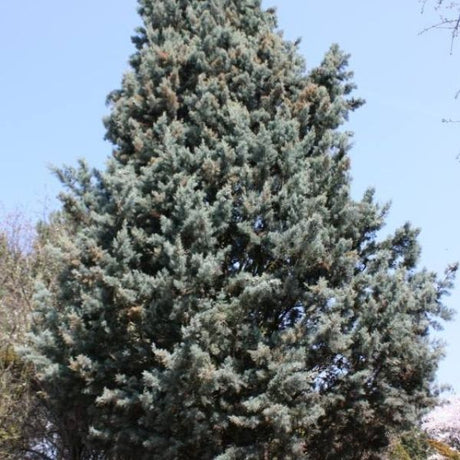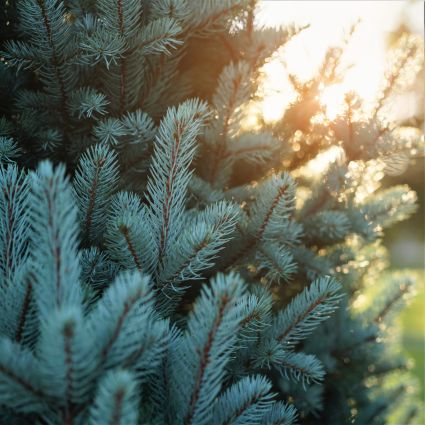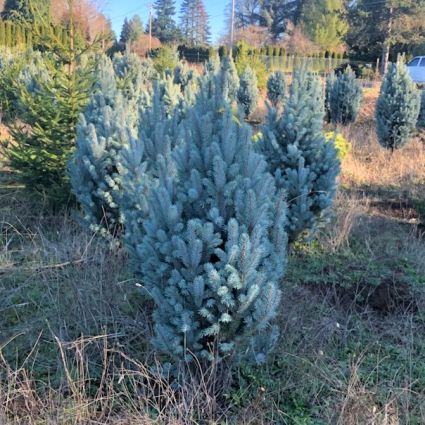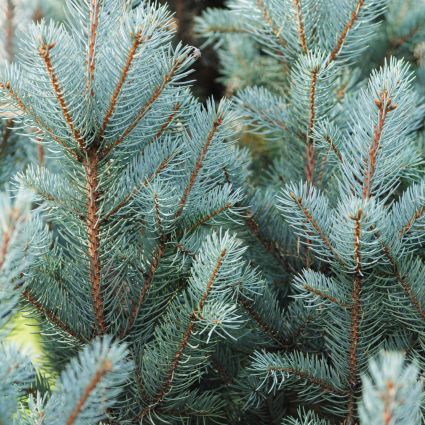There are so many wonderful varieties of evergreen trees around your neighborhood! Sometimes, when you are out for a walk, the novice tree hugger may call them all Pine trees, but with a few moments of inspection, you’ll see they are very different!
In reality, there are many varieties of coniferous evergreen trees out there and with a few moments of closer inspection, you’ll be able to pick out the differences and be able to tell them apart!
Today it’s all about the Spruce Tree!
Spiffy Spruce Trees
Comprised of about 35-40 species of coniferous evergreen trees in the family Pinaceae. These outstanding evergreen coniferous trees are noted for their symmetrical beauty and distinctive colors, making them a dignified landscape asset indeed. The rounded arrangement of the short, sharp needles on Spruce trees is the way to tell if you have a Picea genus!
Spruce trees grow at high altitudes and cooler climates of USDA planting zones 2 to 8, preferring the environments that Mountains provide. The strong, pest and decay-resistant wood is loved for its use for furniture and framing, and are a classic Christmas tree.

Need To Identify A Spruce? Just Remember - Spiky Sharp Square Spruce!
Spruce needles are spiky! The pointed needles are also typically squarish or trapezoids. Most Spruces carry needles in a whirl all around the twig and are adhered to the branches on a small peg-like structure called a sterigma. These structures remain after the needles drop, leaving a stubble-like texture along the branches. The single-born needles themselves are four-sided/angled and with four whitish stripes down the length of each.
- New growth is soft, lighter green bundles covered in a brown papery sheath
- Short, sharp, pointed individual mature needles
- Needles arranged around the entire stem (whirled)
- Individual needles have a four-sided cross-section
- Each needle is held to the stem by sterigmata - which are little post-like structures
- Spruce needles fall off when the tree is 4-10 years old
- Stems and branches without needles are stubbled by remaining sterigmata
- Smaller but bright pink to red or purple upright male cones towards the tops of the tree
- Hanging, slender female cones turn brown with small scales that are tightly packed, papery scales
- Cones don’t fall apart and drop whole once the papery winged seeds have been released when mature. Typically, no spikes on the cone scales.
- Bark ranges from red-brown to gray-brown in flattened plates, sometimes ridged
Spruce cones are oblong and cylindrical and tend to attach to the upper-most limbs of the trees and hang downwards, unlike Fir Trees that stand straight upward. The cones also do not fall apart like Fir, remaining intact when they fall to the ground. The papery scales lack spines or prickles, as many Pines can have.
Native Varieties Of Spruce Trees
Favorites of a wide variety of songbirds, squirrels, and other wildlife, the year-round greenery that is dense and shields creatures from the wind and sun makes Spruce trees an ideal habitat. The stems hold all the way to the ground beautifully for extra protection.
Red Spruce Trees
The Red Spruce (Picea rubens) is typically found throughout Quebec, Nova Scotia, the Adirondack Mountains, and a majority of the Northeastern US. A long-lived species, Red Spruce can live up to 350 years of age. Even taking on part shade of the understory when young. The shiny, yellow-green needles accent the gray-brown and red-brown bark underlayer.
The dangling, papery red-orange-brown cones fall in the autumn as soon as they mature.
- Tall Yellow-Green Square Needles
- Northeastern US & Canada Native
- Grows Up To 115 feet
- Male Cones and Young Female Cones Are Rosy Red-Purple
- 1 ½ Inch Long Drooping Red/Orange-Brown Cones - Drop In Fall
- Red-Brown Bark Under Gray Brown Plates
Going by many names, including the Yellow Spruce, Pocono Spruce, West Virginia Spruce, Eastern Spruce, and He-Balsam. The Red Spruce’s most noteworthy feature is its unique resonance quality, which makes it highly valued for use in pianos, guitars, and other stringed instrument crafting.
White Spruce Trees

The White Spruce Tree (Picea glauca) is a gorgeous soft-green to blue-green needled conifer. Going by many names, these native evergreens are incredibly cold-hardy and water-wise! Useful lumber, these are fantastic wildlife trees, windbreaks, block drifting snow, and the classic conical Christmas Tree! The young male cones are red and succulent before turning yellow when full of pollen,, and the immature female cones are greenish-purple before pollination. Growing about two inches long, the cones are thin and flexible, maturing in one season, and dropping in the winter.
- Soft to Blue-Green Needles
- Conical Shaped Dense Form
- Mature Height 40 - 50 feet
- Mature Spread 20 - 30 feet
- Red Male Cones & Green/Purple Young Female Cones
- Long-Lived Trees
One great variety of White Spruce is the darker-needled Black Hills Spruce Tree found throughout its namesake area of South Dakota. The Dwarf Alberta Spruce (Picea glauca 'Conica') is a slow-growing, very dense cultivar of White Spruce that was discovered in Alberta, Canada. Dwarf Alberta can be grown into bonsai or topiary with some training when young.
Blue Spruce (Picea pungens var. glauca) & Colorado Spruce (Picea pungens)
There are a wide variety of cultivars of Colorado Spruce and similar Blue Spruce Trees, but they are very well-known for their slow-growing, long-lived trees of medium size, because of their symmetry and gorgeous color. There are either seedling-selected varieties or grafted selections chosen for their spring new growth that can range from bright green to blue-green. In summer, the Blue Spruce needles can range from silvery-blue foliage color to aqua-blue-green, while Colorado Spruce is sage to dark green.
Blue Spruce does terribly in wet, humid places with high daytime temperatures, which exposes them to disease and stress, so it is recommended you avoid planting Blue Spruce in these climates.
- Wide Range of Needle Colors - Silver to Green to Blue
- Pyramidal Dense & Symmetrical Form
- Slower-Growing But Very Long-Lived in Drier Climates
- Fat, Fluffy Dense Evergreens
- Red-Orange Male Cones & Purple Immature Female Cones
- 2-4 Inch Long Papery Female Cones
They do very well where well-drained soils and a drier, less humid climate with colder temperatures. With strong lines and a dense pyramidal form, this wonderful evergreen brings structure and a formal polish to your garden design. With a perfect shape and tiered, horizontal branches, Blue Spruce is one of the most popular conifers ever sold.
Popular varieties and grafted cultivars of the Blue Spruce include:
- The soft sage-green Colorado Spruce Tree - aka Silver Spruce
- The slender Columnar Blue Spruce Tree
- Shorter and stockier Fat Albert Colorado Blue Spruce Tree
- The blue forms Colorado Blue Spruce Tree and Baker's Colorado Blue Spruce
- The unique Slenderina Weeping Blue Spruce and Weeping Colorado Blue Spruce
- The miniature Blue Wonder Colorado Spruce Tree
- Dwarf round Dwarf Globe Blue Spruce shrub
From windbreaks to snow-drift plantings, wildlife, and songbird shelters, the Blue Spruce family has an incredibly wide range of sizes, shapes, and forms for you to fill your landscape with and never get bored!
Sitka Spruce (Picea sitchensis)

Tall and one of the largest Spruce, Sitka Spruce trees can be found from Alaska to California. Growing from a broad crown to a cylindrical form with age, the informal branching is full of short stiff, sharp needles that can be a dark glaucous blue-green. The pendulous slender cones have thin papery scales and are the longest of the Spruce family. Male pollen cones are reddish-green before filling with yellow pollen.
- Blue-Green Short, Stiff Needles
- Broad to Cylindrical Crown
- 100+ Feet Tall At Maturity
- Reddish-Green Male Pollen Cones
- Pendulous Slender Papery Cones
- Natives of Coastal Alaska to Northern California
Due to their limited range and their intolerance to drought, Sitka Spruce is not used widely as landscaping trees. They do fantastic in the right setting and unfortunately, the average home garden isn’t it. However, Nature Hills has a wee version of this towering fortress of an evergreen with the dwarf Papoose Sitka Spruce cultivar! Despite its cousin growing up to 100 feet tall, Papoose stays a 4 - 6 feet tall and wide globe shape, has a dense puffy texture, and glaucous blue-green coloration.
Black Spruce Trees (Picea mariana)
The Black Spruce (not to be confused with the Black Hills Spruce) is a fantastic spire-like pyramidal evergreen, with dark blue-green needles and textural branching. The downward-sweeping skinny branches have upturned ends and become bedecked in rounded papery brown cones. Handling cold climates with ease and even tolerating some wet-soil sites, Black Spruce has near-black immature female cones, and immature male pollen-bearing cones are reddish before turning yellowish-brown.
- Dark Blue-Green Short Needles
- Sweeping Slender Branches With Upturned Ends
- 30 to 50 feet
- Grayish-Brown Thin Bark
- Small Cones Dark Purple/Near-Black Become Rounded, Brown & Papery
- Northern American Native
- Loves Higher Moisture - Wetlands, Swamps & Bogs
This evergreen has been used as a traditional medicine and essential oil. In their native habitat throughout North America and Canada, Black Spruces form colonies in wetland areas and poor moist soil locations. Rarely used in the landscape setting because pests and habitat loss threaten these evergreens, and therefore do not do well in urbanized areas.
Engelmann Spruce Tree (Picea engelmannii)

Also known as the Mountain Spruce, the Engelmann Spruce is native throughout the northwestern canyons, alpine, and mountainous regions of the US and Canada. The short pungent needles are blue-green with light blue undersides, filling out tall, slender conical crowns. The purple male cones and red-purple female cones mature after 7 months, with papery, wavy scales.
- Blue-Green/Light Blue Short Needles
- Tall, Narrow-Growing Profile
- Growing 80–130 Feet Tall
- Thin Scaley Bark & Shallow Roots
- Beautiful Purple Male Cones & Reddish-Purple Immature Female Cones
- 1-3 Inch Long Mature Cones With Wavy Papery Scales
- Living 500-600 Years Old
Unlike many evergreens, Engelmann's is tolerant of shade, but little else, so it isn’t widely used in the home landscape setting, these evergreens can grow in harsh cold environments.
Non-Native Spruce Trees
- Norway Spruce is a common non-native European tree that has been extensively planted and naturalized in North America. There are also ornamental Weeping Norway Spruce forms for something whimsical, and space-saving Dwarf Norway Spruce and the Columnar Norway Spruce Tree for smaller landscaping. There is a dwarf grafted form of the Norway, called the Bird's Nest Spruce, that is a cute, rounded shrub form with a depression in the middle resembling its namesake. There is a Norway Spruce named 'Old Tjikko' that is about 9,500 years old.
- Lutz Spruce Tree (Picea x lutzii) - a hybrid cross of Sitka Spruce and White Spruce, and naturally hybridizes throughout the growing region where these two types of evergreens overlap. Growing tall with drooping branching, with cones resembling Sitka and less spikey needles than the White.
- Serbian Spruce Tree (Picea omorika) - Hailing from their namesake region, these symmetrically pyramidal evergreens have pendulous branches and two-tone dark green/silvery needles. The purple cones and arching branches are highly ornamental. No room for a 20-foot-wide tree? Look into the miniature Dwarf Serbian Spruce, or a columnar Bruns Serbian Spruce (Picea omorika 'Bruns'), or the especially ornamental Bruns Weeping Serbian Spruce!
- Korean Spruce Tree (Picea koraiensis) - This conical and easy-to-grow tree has dark blue-green needles that emerge a pale celadon-green. The red-brown trunk is nearly perfectly round and straight, forming a handle for mountainous environments with ease.
- Schrenk's Spruce (Picea schrenkiana), also known as the Asian Spruce, is native to central Asia in western China, Kazakhstan, and Kyrgyzstan. Tall and slender, these trees can easily grow 100 feet in optimal conditions. Especially durable to wind, the strong trunks and columnar pyramidal form look great in groupings and groves.
- Meyer's Spruce (Picea meyeri) A native of China and Russia, Meyer's Spruce has lovely blue-green needles and is are slow and steady grower. Featuring upturned ends and fat, full, and fluffy-looking pyramidal form, this is a good all-round evergreen that is extremely cold-tolerant down to USDA zone 2.
- Brewer Spruce (Picea breweriana) named in honor of the American botanist William Henry Brewer, these are a Western US native with weeping, pendulous branches in soft blue-green.
Fun Spruce Tree Facts

- The original Christmas trees were Spruce!
- Spruce trees have worldwide folklore and superstitions, and are considered sacred in many areas.
- The needles are edible and medicinal, high in Vitamin C. Try making tea or spruce-tip syrup. Treats colds and coughs. Bake Spruce tips in bread, add to salads, and make flavored vinegar or Spruce sugar.
- Spruce beer was popular in the American colonies until the late 1800s
- The oldest Fossil record of Spruce is around 136 million years old from the Early Cretaceous, found in Western Canada.
- The Wright brothers' aircraft “The Wright Flyer” was made from Spruce-wood!
- The lightweight wood has been used for making instruments, furniture, and poles
Spruce Tree Care
Spruce trees need full sun for the strongest, uniform growth and health. Provide a planting area with excellent drainage and moderate yet regular moisture access for their first year. Once established, Spruce won’t need too much extra watering unless drought becomes extensive or you are growing in a very arid climate.
All plants appreciate the life-long symbiotic root support of Nature Hills Root Booster, and a 3-4 inch deep layer of arborist bark chips or pine mulch around their entire root system (just avoid mulch volcanoes and keep the mulch pulled back away from the trunk).
Prune in the spring back to a set of buds, but typically, these evergreen trees are tidy growers and rarely need pruning. They look best given ample room to grow to their mature size, with their limbs intact, sweeping the ground. You will find that allowing the most natural growth and development is very attractive. Do not get the urge to remove the bottom branches for any reason, as they are best branched to the ground.
Spectacular Spruce Trees at Nature Hills!
Spruce is ideal for prominent lawn specimens, wildlife sanctuaries, stopping snow drifts, and windbreaks, and as part of a wildlife-friendly shelterbelt! Get the Christmas tree look year-round today!
Cold-hardy and highly adapted to poor, rocky, and mountainous environments. The Spruce is a resilient tree with easy elegance and visions of grandeur that readily become part of your landscape for generations!
Check out all the evergreen Spruce trees and their many ornamental forms for you to choose from at Nature Hills! Unsure of which Spruce Tree to pick? Click on a photo at NatureHills.com, or check with your local County Extension Office to see which Spruce Trees will perform best in your immediate area!
Next time you are out on a hike or on a stroll around the neighborhood, see how many Spruce trees you can identify!
Check back next time for Part 7: The Cypress!




























